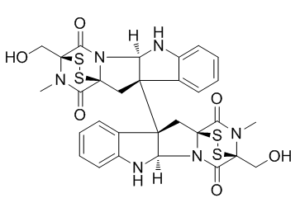This product is for research use only, not for human use. We do not sell to patients.

| Size | Price | Stock |
|---|---|---|
| 100mg | $1875 | Check With Us |
| 200mg | $2810 | Check With Us |
| 500mg | $4745 | Check With Us |
Cat #: V3456 CAS #: 28097-03-2 Purity ≥ 98%
Description: Chaetocin, a naturally occurring fungal mycotoxin extracted from Chaetomium, is a novel and non-specific inhibitor of the histone lysine methyltransferase (HMT) G9a with an IC50 of 2.5 μM. It belongs to the class of 3,6-epidithio-diketopiperazines.
Publications Citing InvivoChem Products
Product Promise

- Physicochemical and Storage Information
- Protocol
- Related Biological Data
- Stock Solution Preparation
- Quality Control Documentation
| Molecular Weight (MW) | 696.84 |
|---|---|
| Molecular Formula | C30H28N6O6S4 |
| CAS No. | 28097-03-2 |
| Storage | -20℃ for 3 years in powder formr |
| -80℃ for 2 years in solvent | |
| SMILES Code | O=C1N(C)[C@]2(CO)C(N3C1(SS2)C[C@@]4([H])[C@]3([H])NC5=C4C(N6C(N7[C@](C(N(C)[C@]8(CO)C7=O)=O)(SS8)C9)C9C%10=C6C=CC=C%10)=CC=C5)=O |
| Synonyms | Chaetocin |
| Protocol | In Vitro | Chaetocin is initially isolated from the fermentation broth of chaetomium minutum and belongs to the class of 3-6 epidithio-diketopiperazines (ETPs). The IC50 for SU(VAR)3-9 is 0.6 μM and acts as a competitive inhibitor for S-adenosylmethionine. Chaetocin inhibits the human ortholog of dSU(VAR)3-9 with a similar IC50 value of 0.8 μM. It inhibits other known Lys9-specific HMTs such as mouse G9a and Neurospora crassa DIM5 with a higher IC50 values of 2.5 and 3 mM, respectively. |
|---|---|---|
| In Vivo | SL-2 Drosophila tissue cells are cultured in the presence or absence of the inhibitor. Chaetocin has a toxic effect on cells grown in culture. Toxicity is highly dependent on the initial cell density when chaetocin is added to the culture. The number of H3 molecules dimethylated at Lys9 (H3K9me2) is markedly reduced when cells are grown in medium containing 0.5 μM chaetocin after 5 d. Histones isolated from cells treated with 0.1 μM and for a shorter time also shows a drop in Lys9 methylation, but not as strongly as with the higher concentration. |
| Solvent volume to be added | Mass (the weight of a compound) | |||
|---|---|---|---|---|
| Mother liquor concentration | 1mg | 5mg | 10mg | 20mg |
| 1mM | 1.4350 mL | 7.1752 mL | 14.3505 mL | 28.7010 mL |
| 5mM | 0.2870 mL | 1.4350 mL | 2.8701 mL | 5.7402 mL |
| 10mM | 0.1435 mL | 0.7175 mL | 1.4350 mL | 2.8701 mL |
| 20mM | 0.0718 mL | 0.3588 mL | 0.7175 mL | 1.4350 mL |
This equation is commonly abbreviated as: C1 V1 = C2 V2
- (1) Please be sure that the solution is clear before the addition of next solvent. Dissolution methods like vortex, ultrasound or warming and heat may be used to aid dissolving.
- (2) Be sure to add the solvent(s) in order.




































